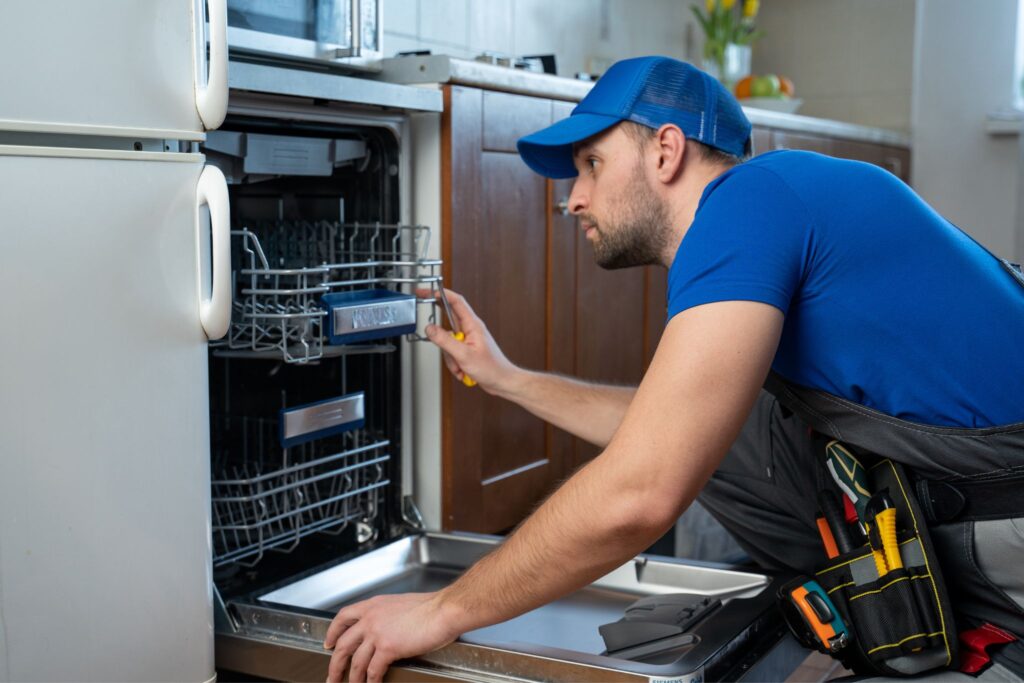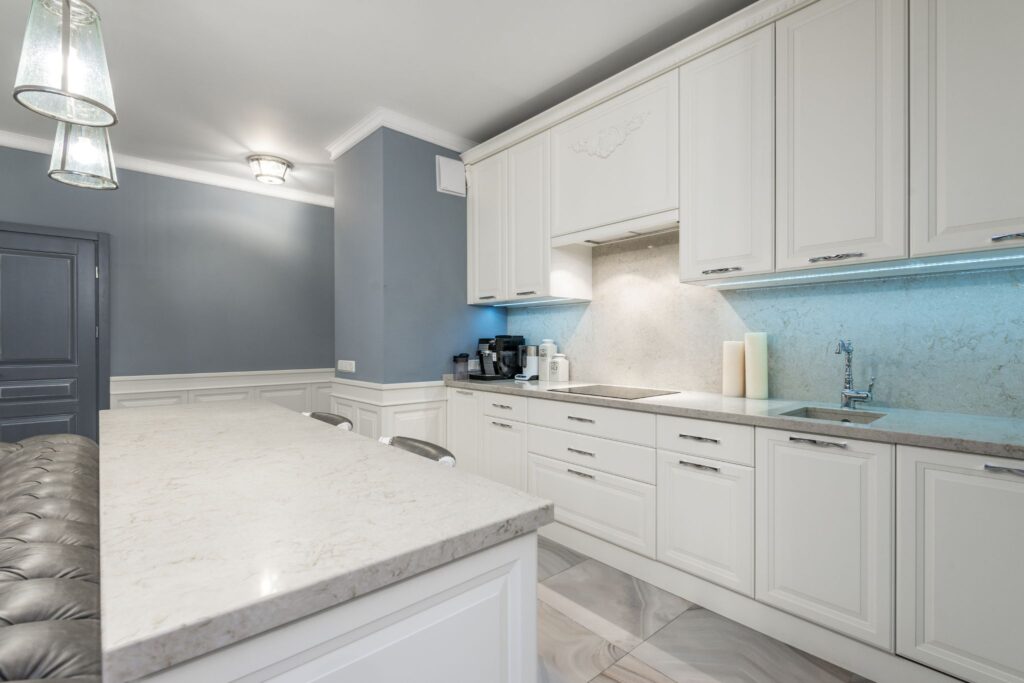Originally Created on: April 11, 2023 @ 10:19 am
How to fit a countertop dishwasher? Let’s find out! Countertop dishwashers have become popular for small kitchens and apartments, as they are a more convenient and space-saving option than traditional dishwashers.
However, installing a countertop dishwasher may seem daunting and complicated, especially if you have never installed a dishwasher before.
Fortunately, installing a countertop dishwasher can be straightforward with the right tools and some basic knowledge. These small appliances are convenient and can be easily installed on your countertop.
However, it’s important to fit and install it correctly to ensure that your new dishwasher works properly and efficiently. If you’re looking to save space in your kitchen or want an easier way to clean dishes without a full-sized dishwasher, a countertop dishwasher is a great option.
In this guide, we’ll take you through the steps of fitting a countertop dishwasher so that you can enjoy its benefits without any issues.
You May Also Like: Can You Wash Pots And Pans In A Countertop Dishwasher [Complete GUIDE + 6 Tips]
Table of Content
How to Fit a Countertop Dishwasher?

To fit a countertop dishwasher, choose a suitable location near a water source and drain. Connect the dishwasher’s water supply line to your faucet, connect the drain hose to the sink’s drain pipe or a suitable drain, plug in the dishwasher, and run a test cycle to ensure it’s working properly.
Before installing your countertop dishwasher, you’ll need to gather a few tools and materials, including a wrench, pliers, a drill, screws, and a water supply line.
You may also need to purchase an adapter for the water supply line, depending on the type of faucet you have.
Once you have everything you need, follow these steps to fit your new dishwasher:
1. Prepare the countertop
Before you place the dishwasher on your countertop, ensure it is level and sturdy enough to support the appliance’s weight. If your countertop is uneven, you may need to use shims to level it out.
You can also reinforce the countertop by adding a piece of wood or metal underneath the dishwasher. Ensure enough clearance above the countertop for the dishwasher to fit properly.
2. Connect The Water Supply
The next step is to connect the water supply line to your faucet. Start by turning off the water supply under the sink.
Then, remove the aerator from your faucet and attach the adapter to the faucet. The adapter will allow you to connect the water supply line to the faucet.
Once the adapter is attached, connect the water supply line to the adapter using a wrench or pliers. Make sure that the connection is tight and secure.
3. Install The Drain Hose
The final step is to install the drain hose. This hose will allow the water to flow from the dishwasher and into the sink. First, attach the hose to the dishwasher’s drain outlet.
Then, route the hose to the sink and attach it to the drain pipe. You may need to use a hose clamp to secure the hose to the drain pipe. Once everything is connected, turn on the water supply and plug in the dishwasher. Test the dishwasher to make sure that it is working properly.
Fitting a countertop dishwasher can be simple if you follow these steps. However, if you’re uncomfortable with plumbing or electrical work, it may be best to hire a professional to install your dishwasher.
With a properly installed countertop dishwasher, you can enjoy the convenience of a dishwasher without taking up valuable space in your kitchen.
Where Should a Countertop Dishwasher Be Placed?

When installing a countertop dishwasher, one of the most important factors to consider is the placement of the appliance.
You want to ensure that the dishwasher is located in a convenient and practical spot that will allow you to use it efficiently.
Here are some things to consider when deciding where to place your countertop dishwasher:
1. Near The Sink
One of the key benefits of a countertop dishwasher is its compact size and portability. This makes placing the dishwasher on your countertop, ideally near your sink, easy.
By placing the dishwasher near the sink, you’ll have easy access to water and drainage for the appliance. You can attach the dishwasher to your faucet using a special adapter and connect the drain hose to the sink’s drain pipe.
This makes filling and draining the dishwasher easy without any extra plumbing work.
2. Away From Heat Sources
When deciding where to place your countertop dishwasher, keeping it away from any heat sources is important. This includes your stove, oven, or other appliances that generate heat.
Placing the dishwasher near a heat source can cause it to overheat, damaging the appliance or even starting a fire.
Instead, place the dishwasher in a cool, dry location where it will be protected from excessive heat.
3. On a Level Surface
Finally, make sure that you place your countertop dishwasher on a level surface. A level surface will ensure the dishwasher operates efficiently and effectively without any leaks or other issues.
If your countertop is uneven, you may need to use shims or other materials to level it out before placing the dishwasher on top. A sturdy, level surface will provide a stable foundation for the dishwasher and help prevent any accidents or spills.
Can You Attach a Dishwasher to a Kitchen Tap?

Yes, it is possible to attach a countertop dishwasher to a kitchen tap. Many countertop dishwashers come with an adapter that allows you to connect the dishwasher’s water supply line to your faucet.
The adapter screws onto the end of your faucet and provides a threaded connection for the water supply line.
This makes it easy to connect the dishwasher to your faucet without any extra plumbing work.
However, not all faucets are compatible with dishwasher adapters. If you have a pull-down faucet or a specialized faucet, you may need to purchase a special adapter to connect your dishwasher.
It’s important to check the specifications of your faucet and dishwasher before attempting to connect them.
In addition, it’s important to make sure that the connection between your faucet and the dishwasher is secure and watertight. A loose or improperly connected adapter can cause leaks and water damage.
Make sure that the adapter is tightened securely and that the water supply line is connected properly.
With a properly connected dishwasher, you can enjoy the convenience of a dishwasher without the need for a dedicated water supply or complicated plumbing.
Conclusion
Fitting a countertop dishwasher might seem like an intimidating task, but it’s actually quite simple if you follow the necessary steps.
By identifying the right location, connecting the water and drain hoses, and properly securing the dishwasher, you can have your countertop dishwasher up and running in no time.
This small appliance can save you time and effort on daily household chores and deliver spotlessly clean dishes ready for the next meal. It’s important to ensure that you carefully read the user manual provided by the manufacturer before installing a countertop dishwasher.
The manual contains vital information about the dishwasher’s features, operation, and recommended installation instructions.
This will ensure you set up the dishwasher correctly and avoid any potential damage. In addition, you will need a few basic tools like pliers, screwdrivers, wrenches, and a few other materials that will be outlined in the manual.
By following the instructions and recommendations provided here, and taking into consideration the guidelines of the manufacturer, the process of installing a countertop dishwasher should be an easy and straightforward task to accomplish.
With a countertop dishwasher, you can enjoy clean and hygienic dishes without having to spend too much time or money on doing them manually.

![How To Fit a Countertop Dishwasher [+3 BEST Tips]](https://mykitchenapex.com/wp-content/uploads/2023/04/How-To-Fit-a-Countertop-Dishwasher-3-BEST-Tips.jpg)